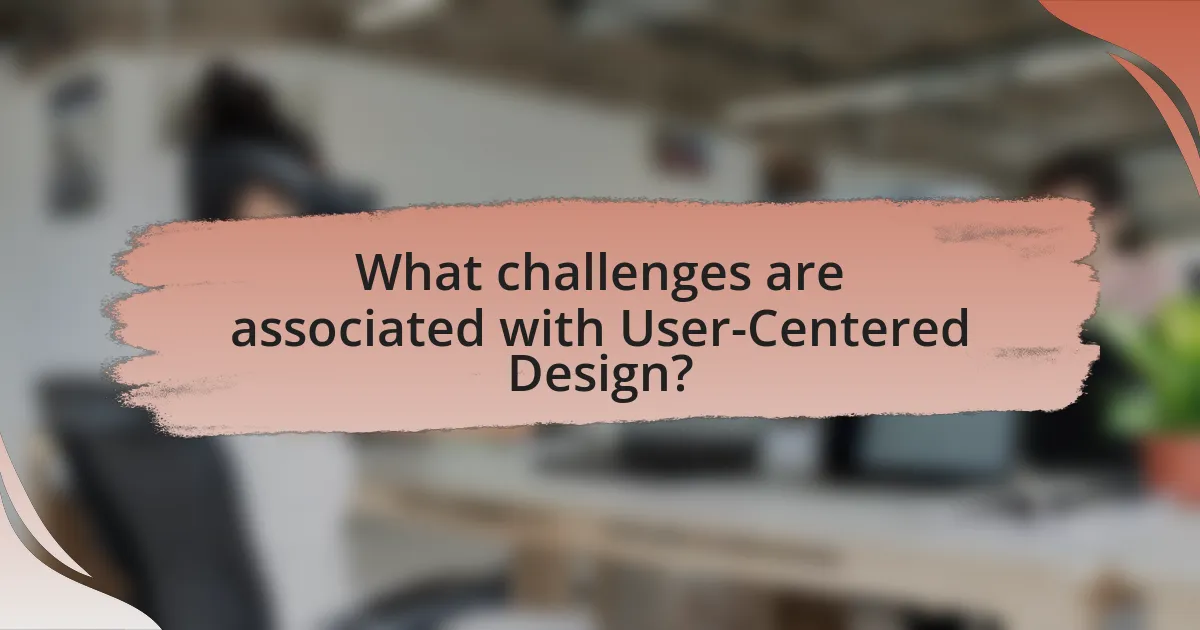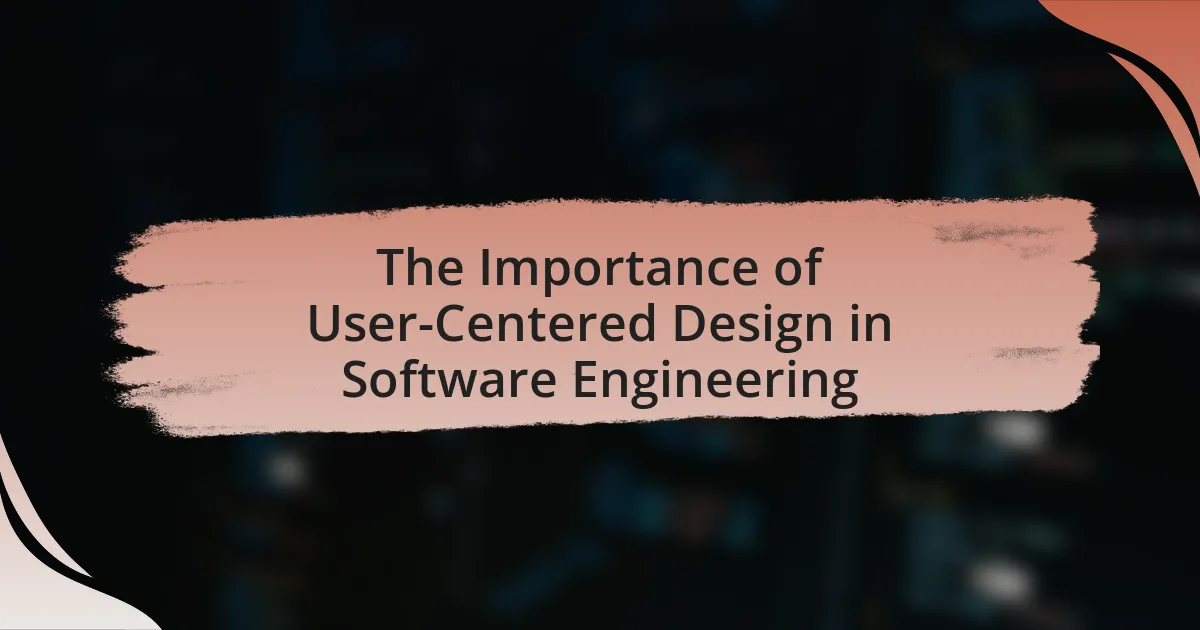User-Centered Design (UCD) in Software Engineering is a design philosophy that emphasizes the needs, preferences, and limitations of end users throughout the software development process. This article explores the principles of UCD, its differences from traditional design approaches, and its significant impact on user experience and software usability. Key benefits of implementing UCD include increased user satisfaction, reduced development costs, and improved product effectiveness. The article also addresses the stages of the UCD process, common challenges faced during its adoption, and best practices for fostering a user-centered culture within organizations.

What is User-Centered Design in Software Engineering?
User-Centered Design (UCD) in Software Engineering is a design philosophy that prioritizes the needs, preferences, and limitations of end users throughout the software development process. UCD involves iterative design and testing, ensuring that user feedback directly informs design decisions, which enhances usability and user satisfaction. Research indicates that software products developed with UCD principles can lead to a 50% reduction in user errors and a 30% increase in user satisfaction, demonstrating its effectiveness in creating user-friendly applications.
How does User-Centered Design differ from traditional design approaches?
User-Centered Design (UCD) focuses on the needs, preferences, and behaviors of end-users throughout the design process, while traditional design approaches often prioritize technical specifications and designer preferences. UCD involves iterative testing and feedback from users, ensuring that the final product is tailored to their actual experiences and requirements. In contrast, traditional design may rely on assumptions about user needs without direct input, potentially leading to products that do not effectively meet user expectations. Research indicates that UCD can improve user satisfaction and usability, as evidenced by a study published in the “International Journal of Human-Computer Studies,” which found that UCD methodologies significantly enhance user engagement and product effectiveness compared to traditional methods.
What principles define User-Centered Design?
User-Centered Design (UCD) is defined by principles that prioritize the needs, preferences, and limitations of end-users throughout the design process. These principles include user involvement, iterative design, and a focus on usability and accessibility. User involvement ensures that designers gather feedback directly from users, which informs design decisions and enhances user satisfaction. Iterative design emphasizes the importance of refining products through repeated cycles of testing and feedback, allowing for continuous improvement. A focus on usability and accessibility guarantees that products are easy to use and accessible to a diverse range of users, including those with disabilities. These principles are supported by research indicating that user-centered approaches lead to higher user satisfaction and better overall product performance.
How does User-Centered Design impact user experience?
User-Centered Design significantly enhances user experience by prioritizing the needs, preferences, and behaviors of users throughout the design process. This approach leads to products that are more intuitive and easier to use, as it involves users in the design stages, allowing for feedback and iterative improvements. Research indicates that implementing User-Centered Design can increase user satisfaction by up to 50%, as it aligns product functionality with user expectations and real-world usage scenarios.
Why is User-Centered Design essential in software development?
User-Centered Design is essential in software development because it prioritizes the needs and preferences of users, leading to more effective and satisfying products. By involving users throughout the design process, developers can identify pain points and usability issues early, which enhances user experience and increases product adoption rates. Research indicates that products designed with user input can achieve up to 50% higher user satisfaction and engagement, as evidenced by a study published in the Journal of Usability Studies, which found that user-centered approaches significantly reduce development costs and time by minimizing revisions and rework.
What are the key benefits of implementing User-Centered Design?
Implementing User-Centered Design (UCD) enhances user satisfaction and usability, leading to improved product adoption and retention. UCD focuses on understanding user needs and behaviors, which results in products that are more intuitive and easier to use. Research indicates that organizations that adopt UCD principles can see a reduction in development costs by up to 50% due to fewer revisions and less need for extensive user training. Additionally, UCD can increase user engagement by up to 80%, as products designed with the user in mind tend to meet their expectations more effectively.
How does User-Centered Design influence software usability?
User-Centered Design (UCD) significantly enhances software usability by prioritizing the needs and preferences of end-users throughout the development process. This approach ensures that software interfaces are intuitive, accessible, and aligned with user expectations, leading to improved user satisfaction and efficiency. Research indicates that UCD can reduce user errors by up to 50% and increase task completion rates by 30%, demonstrating its effectiveness in creating user-friendly software. By involving users in design iterations and usability testing, developers can identify pain points and optimize functionality, ultimately resulting in a more effective and enjoyable user experience.

What are the stages of User-Centered Design in software engineering?
The stages of User-Centered Design (UCD) in software engineering are: research, design, prototyping, evaluation, and implementation. Research involves understanding user needs and context through methods like interviews and surveys. Design focuses on creating user interfaces that meet identified needs, often using wireframes and mockups. Prototyping allows for the development of interactive models to test concepts. Evaluation assesses usability through user testing and feedback, ensuring the design meets user expectations. Finally, implementation involves integrating the design into the final product, ensuring it aligns with user requirements. Each stage is iterative, allowing for continuous improvement based on user feedback.
What steps are involved in the User-Centered Design process?
The User-Centered Design (UCD) process involves several key steps: research, design, prototyping, testing, and iteration. Initially, research is conducted to understand user needs and contexts through methods like interviews and surveys. Following research, the design phase translates user insights into design solutions, focusing on usability and user experience. Prototyping then creates tangible representations of the design, allowing for early visualization and feedback. Testing involves evaluating the prototypes with real users to identify usability issues and gather insights. Finally, iteration refines the design based on user feedback, ensuring the final product meets user needs effectively. This structured approach is essential in software engineering to enhance user satisfaction and product effectiveness.
How do user research and analysis contribute to design?
User research and analysis significantly enhance design by providing insights into user needs, behaviors, and preferences. This understanding allows designers to create solutions that are more aligned with user expectations, ultimately improving usability and satisfaction. For instance, a study by Nielsen Norman Group found that user-centered design can lead to a 50% reduction in development costs and a 200% increase in user satisfaction. By integrating user feedback and data into the design process, teams can identify pain points and prioritize features that deliver real value, ensuring that the final product is both functional and appealing to its intended audience.
What role does prototyping play in User-Centered Design?
Prototyping plays a critical role in User-Centered Design by enabling designers to create tangible representations of their ideas, which can be tested and refined based on user feedback. This iterative process allows for the identification of usability issues early in the design phase, ensuring that the final product aligns closely with user needs and preferences. Research indicates that involving users in the prototyping phase can lead to a 50% reduction in development time and costs, as it minimizes the risk of costly changes later in the project.
How can feedback be effectively integrated into User-Centered Design?
Feedback can be effectively integrated into User-Centered Design by employing iterative design processes that prioritize user input at each stage. This approach involves conducting usability testing, gathering user insights through surveys and interviews, and analyzing user behavior through analytics tools. For instance, a study by Nielsen Norman Group emphasizes that iterative testing with real users leads to significant improvements in design effectiveness, as it allows designers to identify pain points and refine solutions based on actual user experiences. By continuously incorporating user feedback, designers can create more intuitive and user-friendly interfaces, ultimately enhancing user satisfaction and engagement.
What methods are used to gather user feedback?
Surveys, interviews, usability testing, and focus groups are commonly used methods to gather user feedback. Surveys allow for quantitative data collection from a large audience, while interviews provide qualitative insights through direct interaction with users. Usability testing involves observing users as they interact with a product to identify pain points and areas for improvement. Focus groups facilitate discussions among users to explore their perceptions and experiences in a collaborative setting. These methods are validated by their widespread application in user-centered design practices, demonstrating their effectiveness in capturing user needs and preferences.
How does iterative design improve software outcomes?
Iterative design improves software outcomes by enabling continuous refinement based on user feedback. This approach allows developers to identify and address usability issues early in the development process, leading to a product that better meets user needs. Research indicates that iterative design can reduce development time by up to 30% and increase user satisfaction significantly, as it incorporates real user input at multiple stages, ensuring that the final product is more aligned with user expectations and requirements.

What challenges are associated with User-Centered Design?
User-Centered Design (UCD) faces several challenges, including balancing user needs with business goals, managing diverse user expectations, and ensuring effective communication among stakeholders. Balancing user needs with business goals can lead to conflicts, as what users desire may not always align with organizational objectives. Additionally, managing diverse user expectations is complex, as different users may have varying levels of expertise and preferences, making it difficult to create a universally satisfying design. Effective communication among stakeholders is crucial, yet often challenging, as differing priorities and perspectives can hinder the design process. These challenges highlight the intricacies involved in implementing UCD effectively within software engineering.
What common obstacles do teams face when adopting User-Centered Design?
Teams commonly face resistance to change, lack of user research, and insufficient resources when adopting User-Centered Design (UCD). Resistance to change often stems from established workflows and a reluctance to alter existing processes, which can hinder the integration of UCD principles. A lack of user research can lead to design decisions that do not reflect actual user needs, resulting in products that fail to resonate with the target audience. Additionally, insufficient resources, including time, budget, and personnel, can limit the ability to conduct thorough user testing and iterative design, ultimately compromising the effectiveness of UCD implementation. These obstacles are frequently cited in studies, such as the “User-Centered Design: An Integrated Approach” by Norman and Draper, which highlights the importance of addressing these challenges for successful UCD adoption.
How can resource constraints impact User-Centered Design efforts?
Resource constraints can significantly hinder User-Centered Design efforts by limiting the availability of time, budget, and personnel needed for thorough user research and iterative testing. When resources are scarce, design teams may rush through the user research phase, resulting in a lack of understanding of user needs and preferences. This can lead to suboptimal design solutions that do not effectively address user problems. For instance, a study by Nielsen Norman Group highlights that inadequate user testing due to budget constraints can result in products that fail to meet user expectations, ultimately affecting user satisfaction and product success.
What strategies can mitigate resistance to User-Centered Design?
To mitigate resistance to User-Centered Design, organizations can implement strategies such as involving stakeholders early in the design process, providing education on the benefits of User-Centered Design, and fostering a culture of collaboration. Early involvement of stakeholders ensures their needs and concerns are addressed, which can reduce pushback. Educating team members about the positive impacts of User-Centered Design, such as improved user satisfaction and increased product usability, can also help in gaining buy-in. Additionally, promoting collaboration among cross-functional teams encourages diverse perspectives and enhances acceptance of User-Centered Design principles. These strategies are supported by research indicating that stakeholder engagement and education significantly improve project outcomes and user satisfaction.
How can organizations foster a User-Centered Design culture?
Organizations can foster a User-Centered Design culture by integrating user feedback into every stage of the design process. This approach involves conducting regular user research, such as interviews and usability testing, to gather insights that inform design decisions. For instance, companies like IDEO have successfully implemented this by prioritizing user needs and iterating designs based on real user interactions, leading to products that better meet user expectations. Additionally, training employees in user-centered methodologies and promoting cross-functional collaboration among design, development, and marketing teams can further embed this culture within the organization.
What training and resources are necessary for effective User-Centered Design?
Effective User-Centered Design requires training in usability principles, user research methodologies, and design thinking, along with resources such as user testing tools, prototyping software, and access to user feedback platforms. Training programs often include courses on human-computer interaction, cognitive psychology, and interaction design, which equip designers with the necessary skills to understand user needs and behaviors. Resources like usability testing software (e.g., UserTesting, Lookback) and design tools (e.g., Sketch, Figma) facilitate the practical application of these principles. Research indicates that organizations investing in user-centered design training and resources see improved user satisfaction and product usability, as highlighted in studies by the Nielsen Norman Group, which emphasize the correlation between user-centered practices and successful software outcomes.
How can leadership support User-Centered Design initiatives?
Leadership can support User-Centered Design initiatives by prioritizing user experience in strategic decision-making and allocating resources for user research. By integrating user feedback into the development process, leadership ensures that products meet actual user needs, which can lead to increased user satisfaction and retention. Research shows that companies that invest in user-centered design see a return on investment of up to 100% due to improved usability and customer loyalty.
What best practices should be followed for successful User-Centered Design?
Successful User-Centered Design requires continuous user involvement throughout the design process. Engaging users in iterative testing and feedback sessions ensures that the design meets their needs and preferences. Research indicates that involving users can lead to a 50% reduction in development costs and a 30% increase in user satisfaction, as highlighted in the study “The Impact of User-Centered Design on Software Development” by Nielsen Norman Group. Additionally, creating personas and user journey maps helps in understanding user behaviors and expectations, further enhancing the design’s effectiveness.
How can teams ensure continuous user involvement throughout the design process?
Teams can ensure continuous user involvement throughout the design process by implementing regular feedback loops and iterative testing phases. This approach allows teams to gather user insights at multiple stages, ensuring that the design aligns with user needs and preferences. For instance, conducting usability testing sessions after each design iteration enables teams to identify issues and make necessary adjustments based on real user experiences. Research indicates that organizations employing iterative design processes, such as Agile methodologies, report higher user satisfaction and product usability, as they actively incorporate user feedback into each development cycle.
What tools and techniques enhance User-Centered Design practices?
User-Centered Design practices are enhanced by tools and techniques such as user personas, usability testing, wireframing, and prototyping. User personas help designers understand target users by creating detailed profiles based on research, which informs design decisions. Usability testing allows for direct feedback from users on prototypes, ensuring that the design meets their needs and expectations. Wireframing provides a visual guide to the layout and functionality of a product, facilitating early-stage design discussions. Prototyping enables the creation of interactive models that can be tested and iterated upon, leading to improved user experiences. These methods are supported by research indicating that user involvement in the design process significantly increases product usability and satisfaction.

Leave a Reply